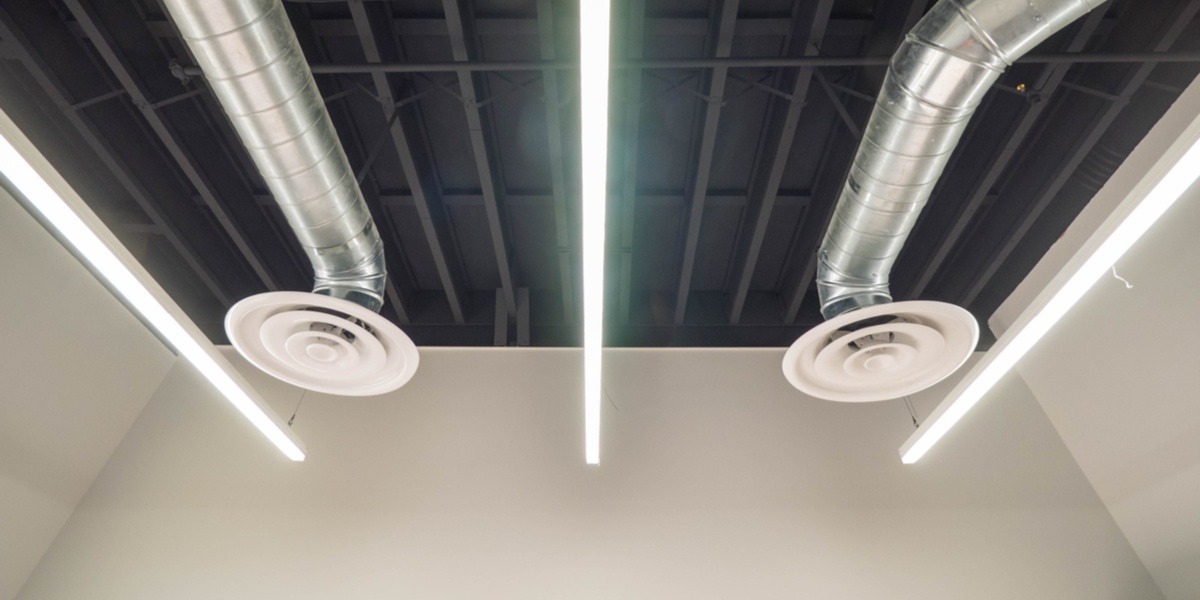Balanced Ventilation system
- Home
- Solutions
- MEP Solutions
- Balanced Ventilation system

Balanced ventilation system differs from other mechanical systems in the market such as local exhaust ventilation (LEV) system and balanced ventilation system; as it doesn’t cause pressure in the room to go up or down. It balances it using two fans for air supply and exhaust to control airflow pressure.
The supply fan brings air from outside to the room, and the exhaust fan takes stale air out.
The system uses a smart process that converts extracted air heat into energy to heat air supply, using a heat exchanger.
Balanced Ventilation system Types
There are two main types of balanced ventilators:
- Heat recovery ventilators (HRV)
- Energy or enthalpy recovery ventilators (ERV)
The 2 systems differ in installation cost, level of energy efficiency, effectiveness in ventilated air distribution and whether there will be a central air handler to distribute air through the house.
The HRV system is better for cold & dry weather.
Unlike the ERV system which is more suitable for humid climates, as it helps in decreasing moisture that comes with outdoor air to the indoor. However, it may need an extra attachment to dehumidify the interior.
How to choose a suitable system type
The climate plays an important role in choosing a suitable balanced ventilator type.
It’s better to install an HRV ventilator in cold or dry climates.
On the contrary, the ERV type is more suitable for humid climates, as it helps reduce moisture brough with outside air. However, a dehumidification addition may be needed in case of high humidity levels.
Balanced ventilation system designs
The HRV & ERV systems can be either a single point, Multi-Point, Multi-Point with Partial Connection to Central Air Handler or Multipoint system with Full Connection to Central Air Handler.

A single point system
This design depends on a single supply point through a single duct, and more than one exhaust point.
However, this design doesn’t provide the ultimate distribution of ventilated air in the whole house.
Multi-Point system (Fully Ducted)
This design is one of the best solutions out there. Although it comes with a high installation cost, it is the most effective and efficient.
It supplies the rooms with fresh air through multi-points duct, that pushes outdoor air to each room connected with the ducts system.
The system evenly distributes fresh air in the house. However, it may need a local exhaust fan in kitchens and bathrooms if the central exhaust point is not located in one of them.
Multi-Point system with Partial Connection to Central Air Handler
This design pulls outdoor air to a central air handler supply trunk before pushing it through the supply ducts with a motorized damper. This regular operation ensures consistent distribution of ventilation airflow.
The air handler is very important in humid climates, as it has to operate whenever the HRV system is operating to avoid condensation in the supply trunk.
Multipoint system with Full Connection to Central Air Handler.
This design takes outside air through the central air handler’s return trunk to the supply trunk, which then pushes the air through the supply ductwork system to distribute it throughout the house.
The system also requires fan cycling, central air handler interlock, and a motorized damper on the supply duct.
It may need a Local exhaust fan in the kitchen or bathroom if the exhaust is not drawn out one of them.
Benefits
The benefits differ according to the design, however, they all provide ventilated air that is drawn from outside and can be filtered.
A single point system design
A single point system design is a simple system that comes with low operation cost and simple controllers. It comes with a small initial cost, as it only needs limited ducting.
Multi-Point system (Fully Ducted) design
Multi-Point system (Fully Ducted) design also comes with low operation cost and simple controllers. It helps in achieving a balanced air distribution throughout the whole house.
Multi-Point system with partial connection to the central air handler and Multi-Point HRV or ERV with full connection to central air handler designs
Multi-Point system with partial connection to the central air handler and Multi-Point HRV or ERV with full connection to central air handler designs comes with an average initial cost for both system types and balanced whole-house air distribution.
Alternatives in the market
What makes the system different than other options available?
Balanced ventilation system doesn’t affect inside pressure as other systems do.
Keep in mind:
It’s better to keep ductwork for the ventilation system and air conditioning system separate; for optimum ventilation and temperature control and to keep the pressure balanced.
